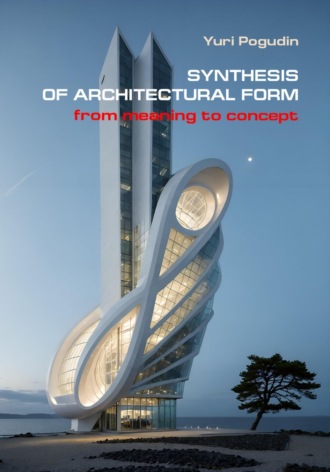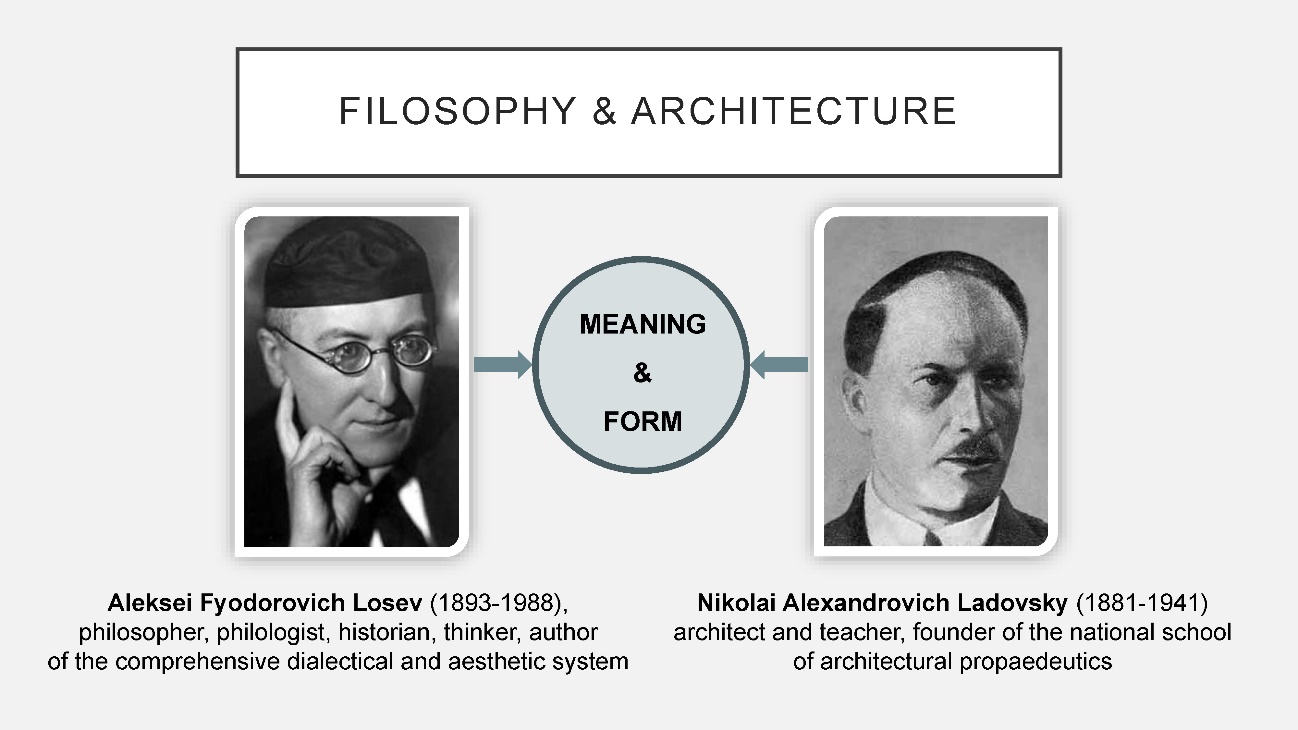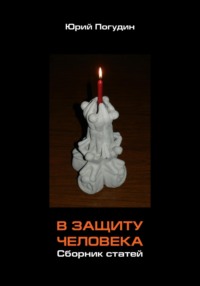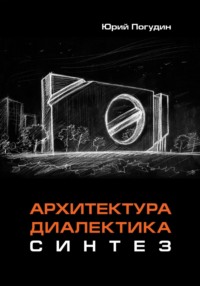
Полная версия
Synthesis of Architectural Form. From Meaning to Concept

Юрий Погудин
Synthesis of Architectural Form. From Meaning to Concept
Life is a controversy waiting for synthesis
A. F. Losev
Dedicated to my family:
my wife Zoe and daughter Taya,
my mother Lyudmila, my father Alexander
and my sister Nina
Preface to the English edition
Dear readers, the translation of this book was performed by a friend of our family, Anna Kanunnikova. I am deeply grateful to her for the work.
The author hopes that the proposed direction will contribute to new architectural searches and discoveries.
September 14, 2025
Preface
Dear readers, I hope that this book will not only be read by you, but also will help you to create expressive architectural compositions.
Realities of the world that is changing before our eyes give rise to new requirements to competences of modern specialists. The active implementation of neural networks in the creative work of artists, designers, and architects brings linguistic and verbal thinking into focus, with its diverse connections with two-dimensional and three-dimensional forms. The connection between words and forms is the point that brings forth the results of the co–creation of human and artificial intelligence. It is in this vein that the author has been conducting research for more than 9 years, the results of which are presented in this book. It outlines the basic principles of communication between verbal/conceptual and figurative/spatial forms of thought. In our Archineo studio, students learn to create new architectural forms using a complex verbal and visual method in a series of certain exercises. A word and an image are two wings. A word is an impulse to create an image. The "clip consumption" of visual content should be replaced with the development of conceptual thinking in its connection with images, space and form. This is the only way a thinking creator can avoid becoming a mere appendage to neural networks, but enter into a co-creative resonance with them. Neural networks will enhance his creative potential, and the person will unlock their advanced capabilities.
The set of reflections in these essays provides a theoretical basis for the harmonious co-creation of human and artificial intelligence in the field of innovative architectural shape generation (form creation, morphogenesis). This book contains no blueprints for using neural networks, but there is something more: it highlights a number of issues on the use of verbal and philosophical methods of thinking in architectural morphogenesis, which is of practical importance both in independent creative search and in the generation of concepts in neural networks.
The author first conceived the idea of combining philosophy and architecture while studying at the St. Petersburg State University of Architecture and Civil Engineering at the Faculty of Architecture. While studying the basics of spatial composition, the history of fine arts and architecture, I first came across the early works of the great Russian philosopher Aleksei Fyodorovich Losev. The term paper in philosophy titled "Architecture as a Subject of Philosophy" (2001) marked the beginning of essays on architectural composition. In the following five years, the preliminary general theoretical part, "The Dialectic of Architecture" (2006), was written. After a few years, thanks to the support of Viktor Petrovich Troitskiy, a senior researcher at the Losev House1, I continued to develop a system of architectural propaedeutics, both theoretical and practical, based on the results of architectural design lessons that I have been giving for more than three years. The proposed methodological principles are applied by my students in their architectural and artistic projects (examples are presented in the final section). Some of them became winners in architectural categories of creative contests for children and youth.
The theoretical core of the book consists of three publications on methods of architectural morphogenesis, published in the St. Petersburg magazine Credo New in 2022-2023.
I deeply and cordially thank my mother Lyudmila, who supports my endeavors; my father Alexander – for helping me in forming my architectural and philosophical library; Uncle Vyacheslav – for my first drawing lessons when I was 2 years old; Grandfather Ivan – for collecting me after classes in art school; Uncle Sergei – for intellectual development; my wife Zoya – for constructive criticism and creative like-mindedness; Viktor Petrovich Troitsky – for wise mentoring and support in the development of the dialectical concept of architectural propaedeutics based on the principles of philosophy and aesthetics of Aleksei Fyodorovich Losev, Sergey Petrovich Ivanenkov – editor-in-chief of Credo New magazine – for help in publishing my articles on architecture; Nikolai Petrovich Pyatakhin, the artist and teacher of drawing in St. Petersburg State University of Architecture and Civil Engineering – for kindness and consistency in the profound mastering of live freehand drawing; Aleksei Dudin, the rector of the Church of the Holy Great Prince Vladimir, Equal of the Apostles in Kommunar Town of the Gatchinsky District, the Leningrad Region, and priest Constantine Slepinin – for prayer support; all the teachers who taught me in Saint Petersburg Gymnasium School No. 114, Saint Petersburg Georgy Sviridov Art School No. 1, Saint Petersburg Interregional Centre (College) of the Ministry of Labour of Russia at the Design faculty, St. Petersburg State University of Architecture and Civil Engineering at the architectural faculty; my students – for the fruitful study and excellent works.
I would be grateful for the feedback and comments that can be sent by email:
yuripogudin@archineo.ru
Have a co-creative reading! Yuri Pogudin,
July 24, 2023
Introduction
One day, the author wrote such a comment to a post about an architectural biennale2: "We can consider the history of modern architecture as a struggle against the peripter. First, the pediment was cut off, and we got a flat roof. The abolition of symmetry gave a free plan and dynamics. The separation from the base gave the "house on pillars". Then we see two parallel processes: identification (walls, wall and roof, etc.) in curvilinear structures and division (walls, wall and roof, etc.) into free elements. The third stage is pixelation: architecture turns into a screen, a mirror, and performance. And electronic baroque. The path of form: from the Egyptian Pyramid to virtual reality."
This somewhat caricatured description reveals categoriality as the basis of architecture: such things as roofs and walls and such qualities as symmetry and transparency are substantive categories for architecture in the same way, as the concepts of finite and infinite, subjective and objective, etc. are for philosophy. Just as a philosopher performs intellectual actions of analysis and synthesis with abstract concepts, so an architect performs visual and material actions with volumetric and spatial forms and their qualities. When Zaha Hadid identified the floor and the wall in the interior through curvilinear plasticity at the Contemporary Arts Center in Cincinnati, it was a new action, it was a new categorial step.
Therefore, architecture can be called a full-fledged philosophy of form, or, if it is more familiar, "philosophy in stone," although it is possible that after a while, we will see the architecture that structures space not with matter, but with force fields. Philosophy, in turn, is the architecture of concepts, the world view of the world creation. The thought of a philosopher connects words–bricks, the thought of an architect – forms, which are concepts and images at the same time.
The thirst for form creation is inherent in people in general, just as the thirst for new music is inherent in composers. The concept of form is integral, and history is the development of forms. The development of meanings stands behind the development of forms. How exactly does a particular form relate to the meaning? What meaning and in what manner does it convey? Precisely these forms flourish in every epoch. And looking at the forms of different epochs and peoples, we can feel for ourselves how different the ideas behind them are. The approach of art experts to appreciate the art of all countries and peoples in the same manner does not devalue the inherent desire of people to find the meaning of life associated with a single Truth. The choice of a world view or religion becomes a choice of an external form, environment, and lifestyle. Aleksei Losev would use here the concept of "myth" – as a historical unity of views, lifestyle of people and the entire created environment.
In the search for new volumetric and spatial compositions, architecture turns to nature and technology, science and art, music and painting, and, of course, philosophy. The achievements of philosophy do not have a generally binding mathematical compulsion, and the choice of philosophical teaching consonant with oneself may in many ways have the character of an aesthetic preference. Thus, the doctrine of the synthesis of opposites in dialectical philosophies seems to the author more beautiful (and therefore more logical) than fixing binary oppositions without resolving their opposition. The apotheosis of this approach was the aphorism of fr. Pavel Florensky: "Rublev's Trinity exists; therefore God exists." In moments of doubt about religious faith, one can consider figure skating: how can such beauty come from nowhere and go nowhere? And Aleksei Losev called his philosophy a "ballet of categories." Logic and beauty, meaning and form are mysteriously interconnected.
Therefore, in the search for architectural beauty and expressiveness, it is logical to turn to philosophy and aesthetics as a storehouse of thought, its constructions, its structurality and movement. The deepest source of this kind is the philosophy of Aleksei Fyodorovich Losev, which has melted down into a new synthesis, a new fusion of ancient, medieval, New European German and Russian Christian philosophy.
The ideas and principles of A. Losev's philosophy can become living seeds for new branches of modern architectural propaedeutics. The author of this book, to the best of his ability, has developed the semantic unity of some of these principles with the concepts of architectural propaedeutics. This work resulted in essays on applied architectural aesthetics – a pedagogical system of dialectical architectural form generation for volumetric and spatial compositions.
A textbook on architectural modeling from the Ural State Academy of Architecture and Art , in our opinion, correctly describes the current situation in architecture: "Somehow, the opinion has prevailed that the impending decline of architecture is manifested only in the "lacking skill" of architects. Increasing this skill in all possible ways is seen as a counteraction to this process. It may go as far as recognition and idealization of the results of the work of a limited group of specialists.
Considering the example of the most important historical changes in architecture, one can see that they were associated not with the loss of craftsmanship, but with the "devaluation of stylistic forms." In this way, the Renaissance revalued the Gothic, the 19th century – the classics, the beginning of our [20 – Yu. P.] century – eclecticism, and then Art Nouveau. Rather, the loss of craftsmanship itself was a consequence of the devaluation of the architectural form. It turns out that the "sacred goal", for which mastery strives, has disappeared.
The devaluation is most clearly expressed in the "feeling of sham randomness of architectural forms.” Sham randomness can in no way convince of its comprehensive justification and realism. Architectural form, therefore, is not just geometry, mass, space, substance, but "an alloy of material with symbolic content, outlined by morphological contours of the form." The form "sweeps along the movements of both our body and our spirit." The truthfulness and organicity of the form are rooted in our consciousness. Spirit and material must be fused together by the meaning. For example, in some objects, the architectural form and material literally coincide, but all this engineering precision does not express any meaning and does not entail any emotions.
When we see in a form only a historical style, only a technical or functional calculation, only the conventionality of language or the irony of the author, we will sooner or later decipher its meaning. However, this meaning is addressed to something different than this form as such. Instead of "referring the viewer to inexhaustible semantic contexts, the form loses its vitality, remaining a conventional sign." <…>
"The fate of the entire architectural culture depends on whether we manage to find a way of thinking that complements scientific analysis and counterposes the diversity of subjective artistic creation to synthesis." [70].
An expressive architectural form, in its inherent meanings, outgrows itself, becoming an intentional existential symbol. Peter Zumthor put it this way: "I did my first two buildings.… It was terrible. I could hear the architectural discussion of the time in my buildings. This was the last time that this should happen to me.... So what is this being myself? It is interesting that in these buildings, which gave me this headache, heart ache, there were things I liked, such as things that did not come from a magazine or from a discussion that I can talk about with somebody. Rather, this is me!" [Quoted after: 58].
The history goes on, and people continue to create. They continue to create architecture as well. New styles replace old ones. Each major style is characterized by a special type of composition. Let's look at the main ones.
Types of Architectural Composition
The development of fine art in general, and the formation of architectural propaedeutics in particular, suggest that there are fundamentally different compositional systems behind the external features and attributes of each of the major styles. In this sense, we can talk about types of composition, each of which has its own internal logic, its own specific structure. At the same time, the individual compositional principles of each of these systems may be included in the arrangement of a different type. But this does not reduce the importance of the originality and uniqueness of a separate compositional system as an internally integrated type that cannot be completely derived from another. We can compare the formation of such a typology with the formulation of the conceptual "DNA" of various architectural styles – with the remark that the "codes" do not encode, but express their specifics.
Next, we will consider in general and essential terms the main historically established types of compositional systems and outline a passage to a new dialectical type developed by the author on the basis of philosophy and aesthetics of Aleksei Fyodorovich Losev.
• Canonical (all "big" styles up to and including Art Nouveau)
• Functional and constructive (Bauhaus, constructivism in the USSR)
• Rationalistic (N. Ladovsky)
• Variative and combinatorial (N. Rochegova, E. Barchugova)
• Intuitive picturesque (K. Malevich, Z. Hadid)
• Bionic
• Dialectical (based on the philosophy of A. Losev)
The first such large type is the canonical composition of classical styles, starting with the ancient Egyptian and ending with the Art Nouveau style. What do such different works as an Egyptian temple and an Art Nouveau mansion have in common?
This is the facade approach to the overall composition of the building, the subtlety of proportional relations, the filigree elaboration of details, the measure, the predominance of symmetry and clear geometric shapes. Most of the classical styles, such as the Greek and Roman architecture of Antiquity, Renaissance, Classicism and Baroque, are based on the order system of composition, which by its nature is a beautiful "garment" of the building. For many people, it has aesthetic fullness and special warmth of forms.
At the beginning of the twentieth century, a functional and constructive type of composition appeared. The general composition of the building, the relative location and the ratio of its parts began to be determined by function and/or structure as priorities. The architecture shed the abundant classical decor as autumn leaves and showed its laconic and strict frame. Regular geometric shapes still prevail, but they are more often connected to each other asymmetrically. The facade is being replaced by working with volume, searching for an asymmetrically balanced expressiveness in the integral structure of the building.
The rationalism of N. Ladovsky stands out against the background of the functional constructivist mainstream of the first half of the twentieth century. This rationalism eventually became the basis of the Russian architectural propaedeutics developed by his students and followers. Ladovsky defined the form guided by two opposite sides: by objective fundamental parameters such as magnitude, mass, tension, etc.; and by the subjective characteristics of the psychophysiological understanding of space by a man. Compositional searches of his students are distinguished by the boldness of their solutions achieving the expressive intensity of forms, but at the same time rationalized by the thought of the comfort of human perception of the city space. Let's call this compositional type rationalistic, after this doctrine.
In modern Russian architectural propaedeutics, lecturers of the Moscow Architectural Institute N. Rochegova and E. Barchugova developed a variable and combinatorial type of composition, which became possible due to the use of computer modeling. The general compositional message is the generation of many different form variants from a few initial "basic" elements – using replication, scaling, displacement, and rotation operations. As a part of such searching, the principles of modernist architecture can still be used to harmonize the composition.
The intuitive picturesque type of architectural composition, which originated in K. Malevich's suprematism, became a kind of "response" to the form rigidly determined by its function and/or structure. The composition with its internal axes is built as a system of spontaneous flows of forms, harmonized by a general equilibrium and a proportional ratio of large masses. The brightest modern representative of this type is Zaha Hadid. Her office has become a center for generating a new style – parametricism. It combines intuitive picturesque artistry with parametric computer modeling of a building as a system, taking into account a variety of specific structural, climatic and other factors.
Let's highlight the bionic type of composition. It is characterized by imitative, stylizing, or literal copying of natural principles and/or forms, including the entire range of organisms from protozoa to humans. Modern architectural bionics is often particularly characterized by its seamless nature, as opposed to the centuries-old established composition, which was in use up to the second half of the 20th century, and, as a rule, included orthogonally connected parts of the building that were articulated and clearly stood out as part of the whole.
So, the composition of a building can be created based on a system of certain artistic principles (such as order), on a function and/or structure, on intuitive artistic vision, on a variable field using the combinatorics of a few initial elements, on the basic properties of spatial form and the peculiarities of their perception (N. Ladovsky). Next, we will reveal another compositional type of form generation – dialectical, which derives compositions from the intrinsic geometric logic of the form in harmony with the purpose of the building.
The school of rationalism of N. Ladovsky – from architectural point of view – and the dialectical aesthetics of A. Losev – from philosophical point of view – play a crucial part in the creation of such compositional system. Let's give a brief overview of both systems.

On the concept of N. A. Ladovsky
The significance of Nikolai Ladovsky's system in architectural pedagogy still requires reflection and coming out of the shadow of other prominent creators of the Soviet avant-garde. It can be said with complete certainty that Ladovsky became the founder of Russian architectural propaedeutics, developed and framed into a system by his students and followers.
No matter how beautiful and harmonious the architectural classic works were and still are, the development of society, science, technology, and art at the turn of the 19th and 20th centuries led to a paradigm shift. The static beauty of a classic building, complete in its symmetry, has been replaced by a building whose form is derived from the concepts of movement, curved space, and the discrepancy between the outer shell and internal premises.
Ladovsky turned to the most fundamental concepts of architecture as a spatial art that cannot be reduced to civil engineering. Space, its finiteness and infinity, the clarity of its perception by people, the calmness and tension of the form, its dynamics reflecting modern history – these are the points and nodes around which the new architectural propaedeutics was formed, which is still relevant today. The system of rationalism is most fully and in great detail revealed in the works of S.O. Khan–Magomedov3.
The same 20s and 30s of the last century saw the birth of fruitful and integral concepts: the one by Nikolai Ladovsky in architecture and pedagogy, and the other by Aleksei Losev in aesthetics and philosophy. Architectural propaedeutics is dynamic and open to new syntheses with philosophical thought. Our task is to show how abstract thought can nourish concrete aesthetics, dialectical philosophy can become a generator of principles for architectural pedagogy, and, perhaps more importantly, to produce an emerging branch of the new architectural aesthetics based not on manifesto negations of past experience, but on the powerful message of the all-unity of Vladimir Solovyov and the supreme synthesis of Aleksei Losev.
Principles of dialectical philosophy of A. F. Losev
Aleksei Losev's philosophy amazes with a combination of depth of thought, simplicity and complexity, consistency and a minimum of special terms, integrity and completeness, boldness and academicism. In a brief digression, it is impossible to summarize and reveal the philosopher's dialectical system in any way completely. Therefore, I will focus on those of its principles that have particularly influenced the development of the proposed dialectic of architectural morphogenesis.
Let's highlight three such principles:
• Reconciliation of opposites in synthesis
• Expression of the whole in its parts
• Presentation of meaning in form
The principle of synthesis is one of Losev's key methodological guidelines, a kind of intrinsic logical leitmotif. Losev's entire philosophy and aesthetics can be called a synthetic one that builds an objective picture of existence as the highest synthesis. This approach opposes formal logic and binary thinking, which fix any semantic oppositions and do not seek their reconciliation in synthesis. So, the concept of "contrast" in the generally accepted compositional propaedeutics for designers and architects is binary, it means a juxtaposition of any parts or qualities of a form. In this point of view, integrity is revealed as a dyad, in which there is no unification of thesis and antithesis.
Let's look at it in details on the example of the specific geometric science. Any category of geometry, starting from a point, is both an abstract mathematical concept, and a verbally logical, and illustratively visual one. If the visual image of an octahedron is a certain combination of images of a square and a circle, then this is simultaneously beautiful in both logical and visual respects. If the dialectical construction shows the movement of categories and beauty in their semantic formation, then both visual and material geometry will be a cast, reflection and expression of this movement and this beauty. The geometric concept becomes the point of intersection of logic and aesthetics.











